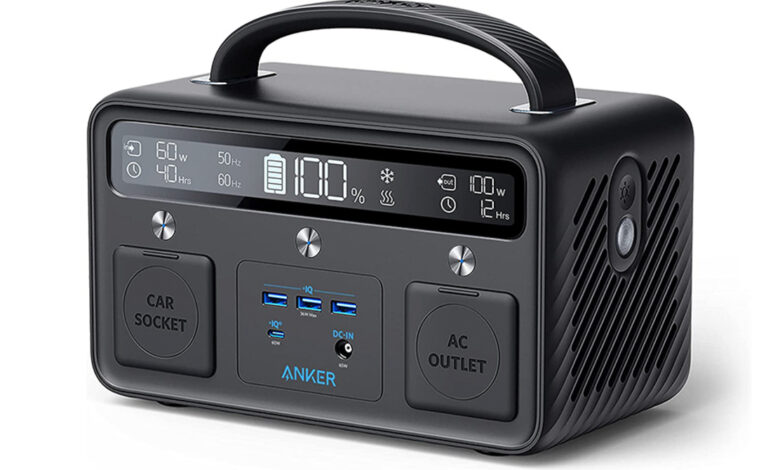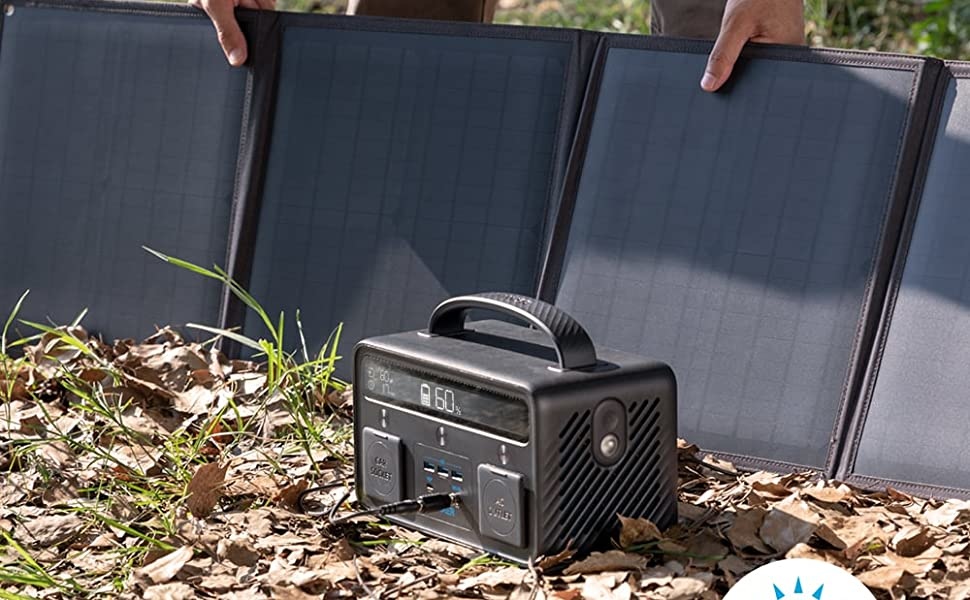Portable power for all your devices: We rate the Anker PowerHouse II 300

If you are someone who spends hours or even days away from power, you know how difficult it is to keep all your devices powered off. With a massive battery and many smart features, the Anker PowerHouse II 300 seeks to overcome that conundrum. In this review, we take a look at PowerHouse and how it works.
I have always been a fan of Anker products. The company produces a wide range of quality electrical products, cables and more at competitive prices and they have never let me down.

The Anker PowerHouse II 300 (model 523) is essentially a very large battery (289 Wh) inside a convenient portable carrying case and is paired with a host of useful features and connections to charge your device. To consider how big the 289 Wh battery is, the PowerHouse II 300 can charge a MacBook Air 2020 3-4 times, an iPad Air 7 times, an iPhone 13 20 times or a regular camera 16 times. It can also run a small refrigerator for more than 5 hours or a typical LED TV for about 6 hours.
Specifications
- Capacity: 80,000mAh / Li-ion battery 289 Wh
- Weight: 4.19 kg / 9.24 lbs
- Dimensions: 255 × 148 × 139 mm / 10 × 5.8 × 5.5 inches
- Output:
- AC: 110 V, 2.72 A (max. 300 W) at 50 or 60 Hz
- USB-A: 5 V, 7.2 A (up to 2.4 A per port)
- USB-C: 5 V, 3 A / 9 V, 3 A / 15 V, 3 A / 20 V, 3 A (up to 60 W)
- DC car socket: 12V, 10A (up to 120 W)
- All ports can be used simultaneously at a maximum of 516 W
- DC input: up to 65 W
- USB-C input: up to 60 W
- DC and USB-C inputs: up to 125 W
- Note: PowerHouse can charge via both DC and USB-C until it reaches 81%, then it will only use DC
- Solar input: 7.9 mm x 0.9 mm . male connector
- 8 ports:
- 300 W . AC outlet
- USB-C port 60 W
- 3 USB-A ports
- Car socket
- 2 DC ports
- PowerIQ 3.0 USB-C port can charge MacBook Air 2020 to 50% in about 40 minutes or iPhone 13 to 50% in about 30 minutes
- Built-in flashlight with low brightness, full brightness and SOS mode
- Built-in LED with three levels for ambient light
- LED display shows battery capacity, current input and output status, and estimated recharge time
- Recharge time: 5 hours with standard charger, 3 hours 20 minutes with fast charge (DC and USB-C)
Content, Design and Setup
In the box as follows:
- Anker 523 . mobile power station
- 65 W . power adapter
- USB-A to USB-C cable
- USB-C to USB-C cable
- Car port to DC cable
- Welcome guide
The device is typical of other Anker products, using a blend of black with blue accents, helping it blend in well with the environment. It’s pretty sturdy, with a drop-resistant unibody construction and a built-in handle that makes it easy to transport. It feels pretty solid and looks nice.
The display is nice, has good backlighting, and the characters are large, making it easy to read in any situation. In the middle is a percentage indicator that shows how much battery is left. On the left, current input power and time until full charge are displayed, while on the right, current output power and time until full discharge are displayed.

The lights are a particularly well thought out highlight, with Anker clearly designing them with the way they will be used in mind. The flashlight on the end is short so that the light is parallel to the handle, so the flashlight can be easily used while carrying the PowerHouse. The LED has a long side, which helps the light to spread evenly over a wider area, more suitable for ambient use.
Ports are easily accessible, with three USB-A, USB-C and DC-in ports centrally located. On the left side, the car outlet and two DC ports are covered by a rubber cover, and on the right side, the AC outlet is covered by a similar cover. Note that the AC outlet is three-prong, so you don’t have to worry about being able to use a grounded plug. I wish the USB ports came with similar caps. Of course, it’s not likely that you’ll use the device in the rain, but if you’re taking it camping or something, there’s always a chance of a random crash or something like that.
Usage and Performance
Usage is as simple as you would expect. At 9.2 lbs (4.2 kg), the device is quite heavy but not too heavy, and when it comes to batteries, their weight should balance out their capacity, so no one should expect a lightweight device if they want good storage.
Both lights are bright for their intended purpose, and the ambient bar’s warm temperatures are appreciated. Turn on the light or plug in the device and press the corresponding control button, and the screen will light up to show the remaining charge, current capacity and remaining time. I find it quite accurate; I plugged in my 85 watt MacBook Pro charger and it always operated at 85 watts and more importantly, the charging rate matched the charging rate of the fixed outlet. After a few seconds, the screen turns off again to save power, but you can tap the button to see it again.
While the laptop was plugged in, I added my phone and tablet and they also charged at full speed with no issues. Of course, it’s nice not to have to set anything up manually; The device will automatically maximize the charging speed. Note that the AC outlet maxes out at 300 watts, so don’t expect to plug something like a space heater into the unit, but any electronics should be perfectly fine.

Charging the PowerHouse is equally easy. You can plug it into a standard home outlet, use your car cigarette lighter, use USB-C, or use solar panels. The car option is nice, as you can simply leave it in your car for shooting or travel without having to carry it around or worry about forgetting it. And, of course, with solar, you can charge completely off-grid and for free. A solar panel will max out a 65 watt DC input and charge the device in 5 hours is about $100, making it relatively cost effective and easy to handle heavy power needs even without the power grid at all.
So, what would all that capacity add up to? Let’s say I’m shooting with a MacBook Air (52.6 Wh), EOS R5 and four batteries (15 Wh each), an iPhone (9.3 Wh), a hair fan (20 W), and a Broncolor single-color light (battery 72). Wh). At 289 Wh, I can expect that after using them all, I can charge my laptop, phone, monolight, and all four camera batteries at a time, plus run the fan for about four hours. . That is definitely more than enough to get most of the ads over the course of a day. Throw in a 60 watt solar panel, and you’ll have a hard time depleting the device completely. And in fact, even with my multitude of devices, including laptops, phones, tablets, multiple camera batteries, fans, purifiers, two sets of headphones, etc., the charging needs of I never exceed PowerHouse or my abilities. it turns off again. It easily keeps up with me on all-day shoots or trips, or if you experience a power outage, you can stay entertained and keep all your essentials running until it’s back up. again.
What I like
- Ambient light and flashlight are good and well thought out gadgets
- Electricity all day at competitive rates
- Various types of ports with fast charging protocol
- Capable of car AC, DC, USB and solar charging
- Can be charged via AC and USB simultaneously for shorter charging time
- The information screen is clear and easy to read
- Solid construction
- Built-in handle
What I don’t like
- Unprotected USB and DC-in ports
Conclusion and Purchase
Overall, the Anker PowerHouse II 300 is a well-built, carefully designed device that’s powerful and versatile, making it an easy proposition. You can buy yours here. If you have slightly different needs, the closest alternatives are the 521 and 535 models Model 521 it’s about $100 cheaper and sacrifices about 10% capacity and can only output at 200 watts through the AC port, but it uses a newer LiFePO4 battery, which has about five times the lifespan of Li-ion. The Model 535 $240 more expensive, but 70% more capacity, more ports, higher output, and uses LiFePO4 batteries.




